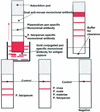Rapid diagnostic tests for malaria parasites
- PMID: 11781267
- PMCID: PMC118060
- DOI: 10.1128/CMR.15.1.66-78.2002
Rapid diagnostic tests for malaria parasites
Abstract
Malaria presents a diagnostic challenge to laboratories in most countries. Endemic malaria, population movements, and travelers all contribute to presenting the laboratory with diagnostic problems for which it may have little expertise available. Drug resistance and genetic variation has altered many accepted morphological appearances of malaria species, and new technology has given an opportunity to review available procedures. Concurrently the World Health Organization has opened a dialogue with scientists, clinicians, and manufacturers on the realistic possibilities for developing accurate, sensitive, and cost-effective rapid diagnostic tests for malaria, capable of detecting 100 parasites/microl from all species and with a semiquantitative measurement for monitoring successful drug treatment. New technology has to be compared with an accepted "gold standard" that makes comparisons of sensitivity and specificity between different methods. The majority of malaria is found in countries where cost-effectiveness is an important factor and ease of performance and training is a major consideration. Most new technology for malaria diagnosis incorporates immunochromatographic capture procedures, with conjugated monoclonal antibodies providing the indicator of infection. Preferred targeted antigens are those which are abundant in all asexual and sexual stages of the parasite and are currently centered on detection of HRP-2 from Plasmodium falciparum and parasite-specific lactate dehydrogenase or Plasmodium aldolase from the parasite glycolytic pathway found in all species. Clinical studies allow effective comparisons between different formats, and the reality of nonmicroscopic diagnoses of malaria is considered.
Figures





Comment in
-
Malaria rapid diagnostic tests: one size may not fit all.Clin Microbiol Rev. 2002 Oct;15(4):771; discussion 771-2. doi: 10.1128/CMR.15.4.771-772.2002. Clin Microbiol Rev. 2002. PMID: 12364379 Free PMC article. No abstract available.
References
-
- Baird, J. K., Purnomo, and T. R. Jones. 1992. Diagnosis of malaria in the field by fluorescence microscopy of QBC capillary tubés. Trans. R. Soc. Trop. Med. Hyg. 86:3–5. - PubMed
-
- Barker, R. H., N. T. Banchongaksorm, M. M. Courval, W. Suwonkerd, K. Rimwungtragoon, and D. R. Wirth. 1992. A simple method to detect Plasmodium falciparum infection in human patients: a comparison of the DNA probe method to microscopic diagnosis. Am. J. Trop. Med. Hyg. 41:266–272. - PubMed
-
- Beadle, C., G. W. Long, W. R. Weiss, P. D. Meelroy, S. M. Maret, A. J. Oloo, and S. L. Hoffman. 1994. Diagnosis of malaria by detection of Plasmodium falciparum HRP-2 antigen with a rapid dipstick-capture assay. Lancet, i:564–568. - PubMed
-
- Benito, A., J. Roche, R. A. Molina, C. Amela, and J. Altar. 1994. Application and evaluation of QBC® malaria diagnosis in a holoendemic area. Appl. Parasitol. 35:266–272. - PubMed
-
- Bosch, I., C. Bracho, and H. A. Perez. 1996. Diagnosis of malaria by acridine orange fluorescent microscopy in an endemic area of Venezuela. Mem. Inst. Oswaldo Cruz 91:83–86. - PubMed
Publication types
MeSH terms
Substances
LinkOut - more resources
Full Text Sources
Other Literature Sources
Medical

